Analysis of Greenway Medical Technologies' E-Health Record System
VerifiedAdded on 2023/03/21
|28
|6170
|68
Report
AI Summary
This report provides a comprehensive analysis of Greenway Medical Technologies' E-Health Record (EHR) system, focusing on its implementation and impact within the healthcare industry. It begins with background information on the importance of EHRs, followed by an executive summary, and key recommendations for adoption. The report delves into the strategic context of EHRs, including a SWOT analysis and mission statement, and employs a business process model to illustrate system operations. A detailed analysis of the investment, including a multi-criteria approach, financial benefits (NPV, ROI, IRR, and breakeven point), and non-financial benefits, is presented. The report also addresses project and social/ethical risks, stakeholder analysis, and benefits realization strategies, including project governance, risk management, and key performance indicators. Finally, it explores the ethical and social implications of EHRs, including customer principles, potential risks, and measures to ensure acceptable outcomes, before concluding with the limitations of the study.

Running head: E-HEALTH RECORD SYSTEM
Greenway Medical Technologies: The Pace-Setting David of Electronic Health Records
Name of the Students
Name of the University
Author’s Note
Greenway Medical Technologies: The Pace-Setting David of Electronic Health Records
Name of the Students
Name of the University
Author’s Note
Paraphrase This Document
Need a fresh take? Get an instant paraphrase of this document with our AI Paraphraser
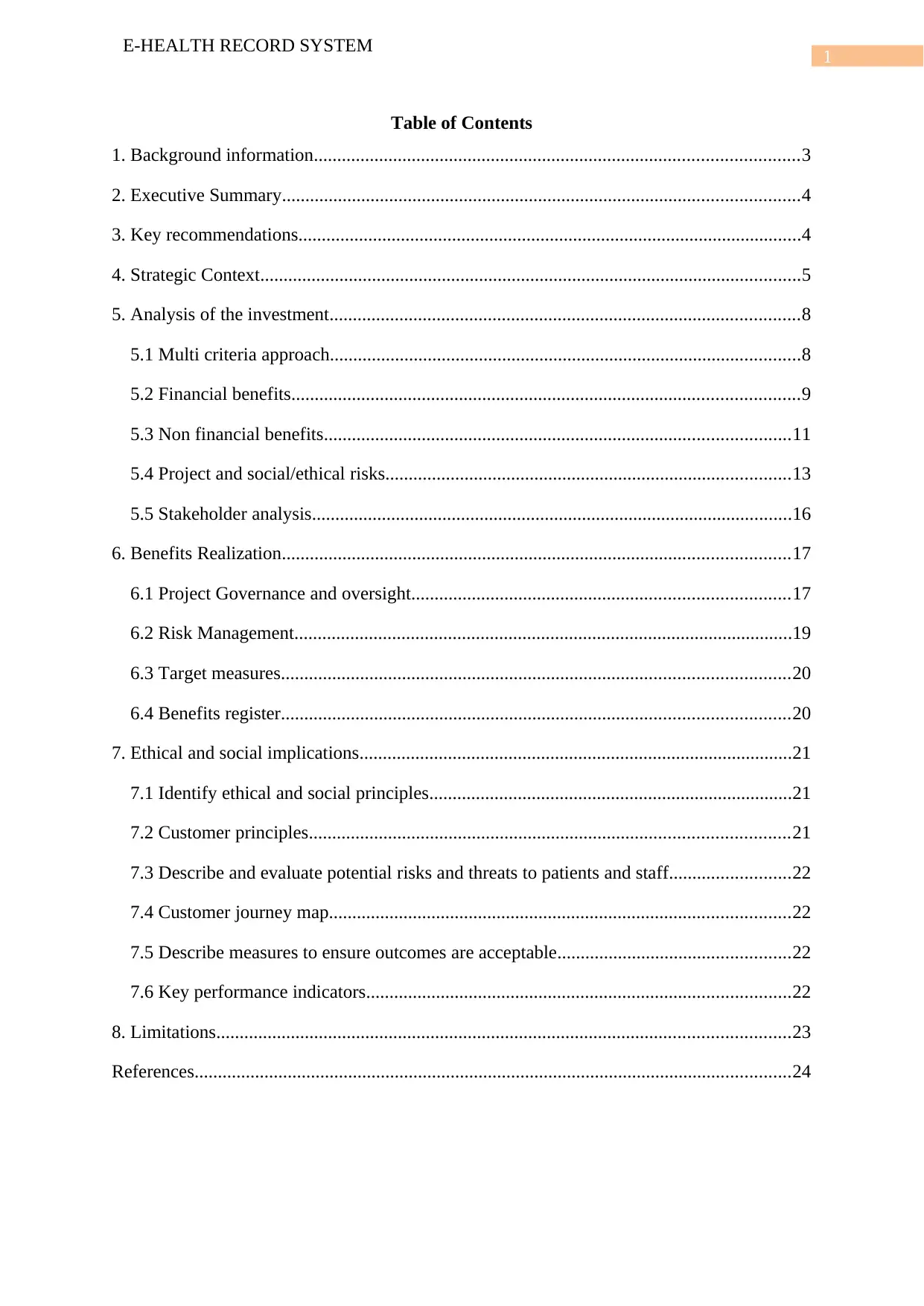
1
E-HEALTH RECORD SYSTEM
Table of Contents
1. Background information........................................................................................................3
2. Executive Summary...............................................................................................................4
3. Key recommendations............................................................................................................4
4. Strategic Context....................................................................................................................5
5. Analysis of the investment.....................................................................................................8
5.1 Multi criteria approach.....................................................................................................8
5.2 Financial benefits.............................................................................................................9
5.3 Non financial benefits....................................................................................................11
5.4 Project and social/ethical risks.......................................................................................13
5.5 Stakeholder analysis.......................................................................................................16
6. Benefits Realization.............................................................................................................17
6.1 Project Governance and oversight.................................................................................17
6.2 Risk Management...........................................................................................................19
6.3 Target measures.............................................................................................................20
6.4 Benefits register.............................................................................................................20
7. Ethical and social implications.............................................................................................21
7.1 Identify ethical and social principles..............................................................................21
7.2 Customer principles.......................................................................................................21
7.3 Describe and evaluate potential risks and threats to patients and staff..........................22
7.4 Customer journey map...................................................................................................22
7.5 Describe measures to ensure outcomes are acceptable..................................................22
7.6 Key performance indicators...........................................................................................22
8. Limitations...........................................................................................................................23
References................................................................................................................................24
E-HEALTH RECORD SYSTEM
Table of Contents
1. Background information........................................................................................................3
2. Executive Summary...............................................................................................................4
3. Key recommendations............................................................................................................4
4. Strategic Context....................................................................................................................5
5. Analysis of the investment.....................................................................................................8
5.1 Multi criteria approach.....................................................................................................8
5.2 Financial benefits.............................................................................................................9
5.3 Non financial benefits....................................................................................................11
5.4 Project and social/ethical risks.......................................................................................13
5.5 Stakeholder analysis.......................................................................................................16
6. Benefits Realization.............................................................................................................17
6.1 Project Governance and oversight.................................................................................17
6.2 Risk Management...........................................................................................................19
6.3 Target measures.............................................................................................................20
6.4 Benefits register.............................................................................................................20
7. Ethical and social implications.............................................................................................21
7.1 Identify ethical and social principles..............................................................................21
7.2 Customer principles.......................................................................................................21
7.3 Describe and evaluate potential risks and threats to patients and staff..........................22
7.4 Customer journey map...................................................................................................22
7.5 Describe measures to ensure outcomes are acceptable..................................................22
7.6 Key performance indicators...........................................................................................22
8. Limitations...........................................................................................................................23
References................................................................................................................................24
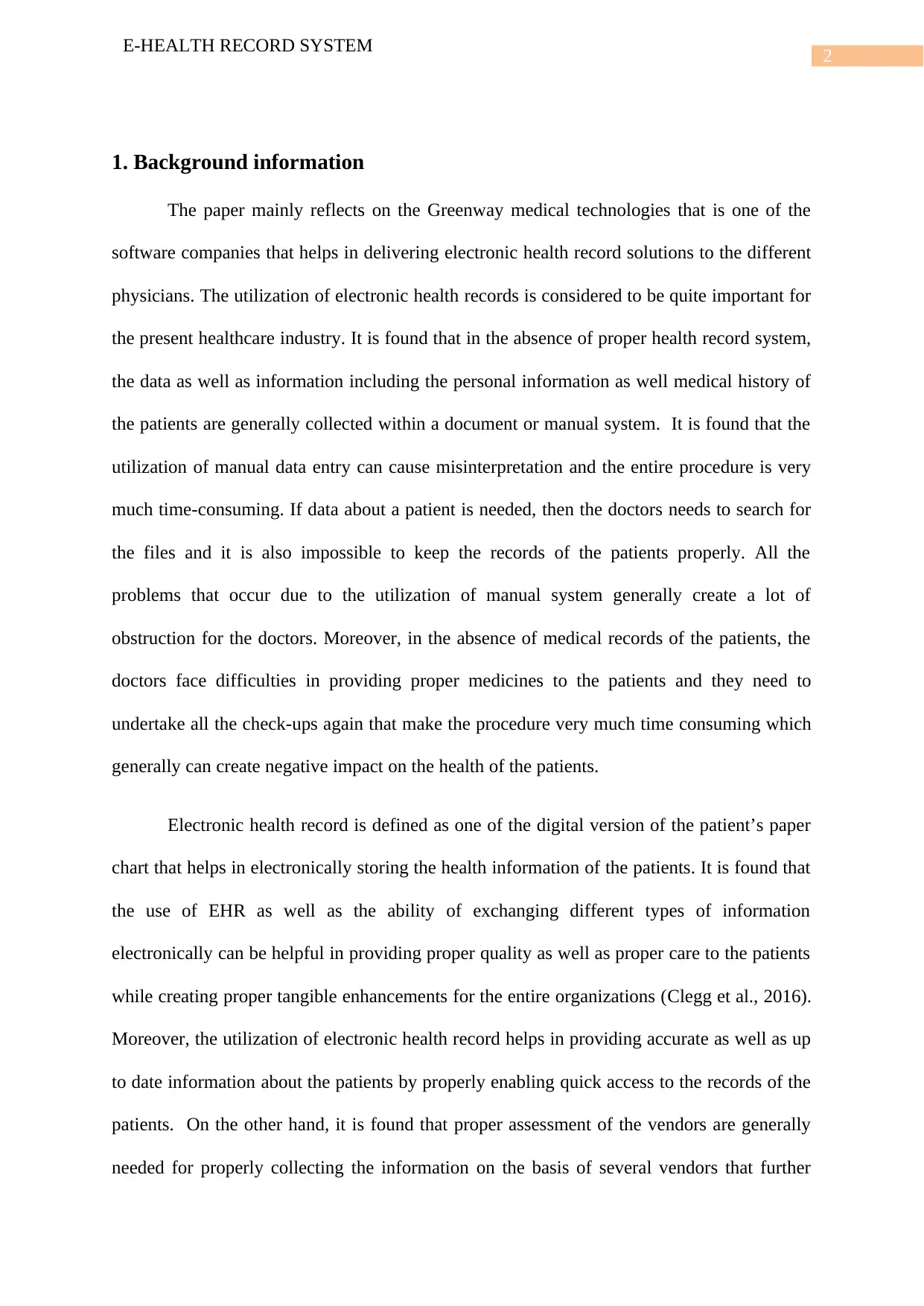
2
E-HEALTH RECORD SYSTEM
1. Background information
The paper mainly reflects on the Greenway medical technologies that is one of the
software companies that helps in delivering electronic health record solutions to the different
physicians. The utilization of electronic health records is considered to be quite important for
the present healthcare industry. It is found that in the absence of proper health record system,
the data as well as information including the personal information as well medical history of
the patients are generally collected within a document or manual system. It is found that the
utilization of manual data entry can cause misinterpretation and the entire procedure is very
much time-consuming. If data about a patient is needed, then the doctors needs to search for
the files and it is also impossible to keep the records of the patients properly. All the
problems that occur due to the utilization of manual system generally create a lot of
obstruction for the doctors. Moreover, in the absence of medical records of the patients, the
doctors face difficulties in providing proper medicines to the patients and they need to
undertake all the check-ups again that make the procedure very much time consuming which
generally can create negative impact on the health of the patients.
Electronic health record is defined as one of the digital version of the patient’s paper
chart that helps in electronically storing the health information of the patients. It is found that
the use of EHR as well as the ability of exchanging different types of information
electronically can be helpful in providing proper quality as well as proper care to the patients
while creating proper tangible enhancements for the entire organizations (Clegg et al., 2016).
Moreover, the utilization of electronic health record helps in providing accurate as well as up
to date information about the patients by properly enabling quick access to the records of the
patients. On the other hand, it is found that proper assessment of the vendors are generally
needed for properly collecting the information on the basis of several vendors that further
E-HEALTH RECORD SYSTEM
1. Background information
The paper mainly reflects on the Greenway medical technologies that is one of the
software companies that helps in delivering electronic health record solutions to the different
physicians. The utilization of electronic health records is considered to be quite important for
the present healthcare industry. It is found that in the absence of proper health record system,
the data as well as information including the personal information as well medical history of
the patients are generally collected within a document or manual system. It is found that the
utilization of manual data entry can cause misinterpretation and the entire procedure is very
much time-consuming. If data about a patient is needed, then the doctors needs to search for
the files and it is also impossible to keep the records of the patients properly. All the
problems that occur due to the utilization of manual system generally create a lot of
obstruction for the doctors. Moreover, in the absence of medical records of the patients, the
doctors face difficulties in providing proper medicines to the patients and they need to
undertake all the check-ups again that make the procedure very much time consuming which
generally can create negative impact on the health of the patients.
Electronic health record is defined as one of the digital version of the patient’s paper
chart that helps in electronically storing the health information of the patients. It is found that
the use of EHR as well as the ability of exchanging different types of information
electronically can be helpful in providing proper quality as well as proper care to the patients
while creating proper tangible enhancements for the entire organizations (Clegg et al., 2016).
Moreover, the utilization of electronic health record helps in providing accurate as well as up
to date information about the patients by properly enabling quick access to the records of the
patients. On the other hand, it is found that proper assessment of the vendors are generally
needed for properly collecting the information on the basis of several vendors that further
⊘ This is a preview!⊘
Do you want full access?
Subscribe today to unlock all pages.

Trusted by 1+ million students worldwide
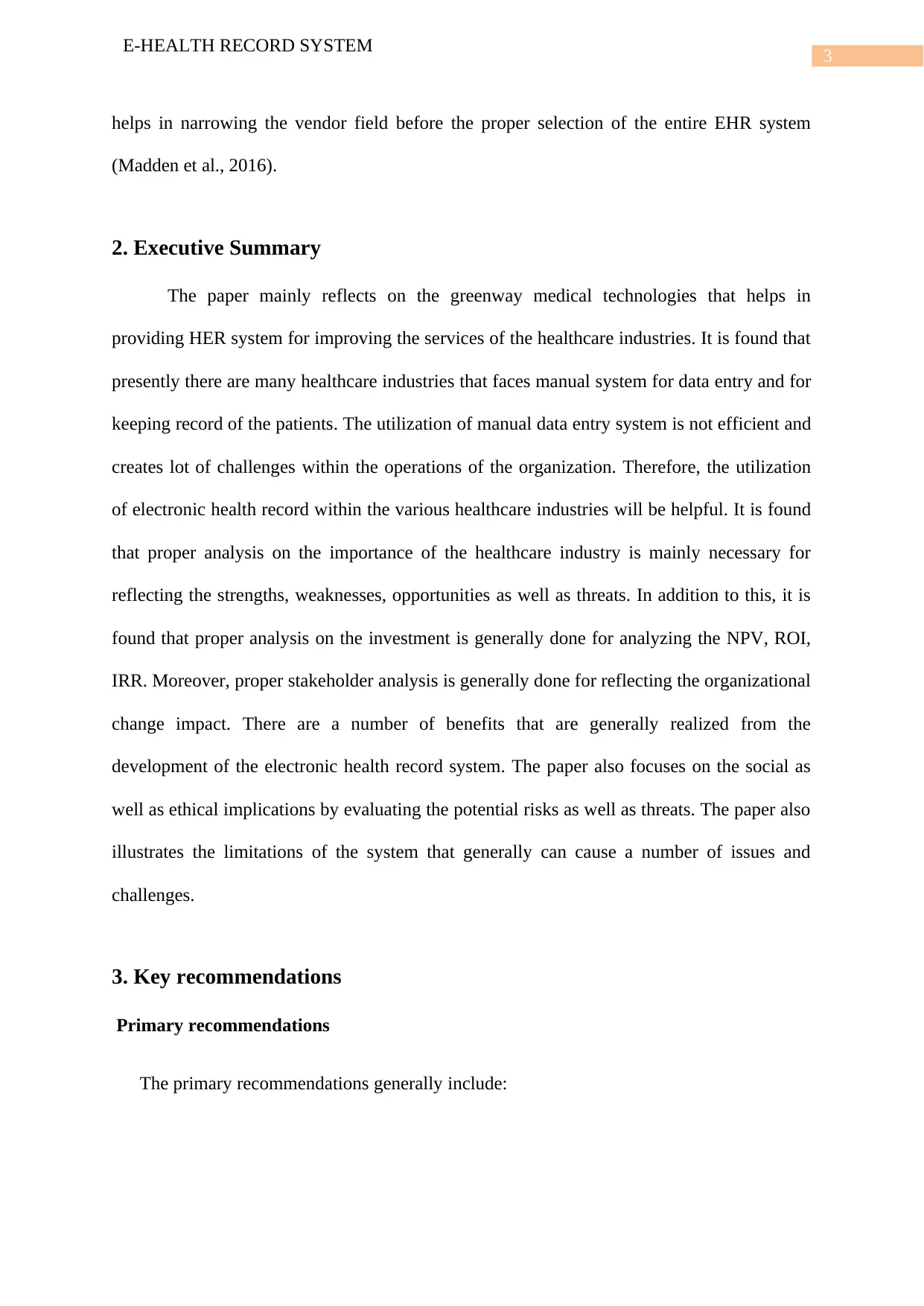
3
E-HEALTH RECORD SYSTEM
helps in narrowing the vendor field before the proper selection of the entire EHR system
(Madden et al., 2016).
2. Executive Summary
The paper mainly reflects on the greenway medical technologies that helps in
providing HER system for improving the services of the healthcare industries. It is found that
presently there are many healthcare industries that faces manual system for data entry and for
keeping record of the patients. The utilization of manual data entry system is not efficient and
creates lot of challenges within the operations of the organization. Therefore, the utilization
of electronic health record within the various healthcare industries will be helpful. It is found
that proper analysis on the importance of the healthcare industry is mainly necessary for
reflecting the strengths, weaknesses, opportunities as well as threats. In addition to this, it is
found that proper analysis on the investment is generally done for analyzing the NPV, ROI,
IRR. Moreover, proper stakeholder analysis is generally done for reflecting the organizational
change impact. There are a number of benefits that are generally realized from the
development of the electronic health record system. The paper also focuses on the social as
well as ethical implications by evaluating the potential risks as well as threats. The paper also
illustrates the limitations of the system that generally can cause a number of issues and
challenges.
3. Key recommendations
Primary recommendations
The primary recommendations generally include:
E-HEALTH RECORD SYSTEM
helps in narrowing the vendor field before the proper selection of the entire EHR system
(Madden et al., 2016).
2. Executive Summary
The paper mainly reflects on the greenway medical technologies that helps in
providing HER system for improving the services of the healthcare industries. It is found that
presently there are many healthcare industries that faces manual system for data entry and for
keeping record of the patients. The utilization of manual data entry system is not efficient and
creates lot of challenges within the operations of the organization. Therefore, the utilization
of electronic health record within the various healthcare industries will be helpful. It is found
that proper analysis on the importance of the healthcare industry is mainly necessary for
reflecting the strengths, weaknesses, opportunities as well as threats. In addition to this, it is
found that proper analysis on the investment is generally done for analyzing the NPV, ROI,
IRR. Moreover, proper stakeholder analysis is generally done for reflecting the organizational
change impact. There are a number of benefits that are generally realized from the
development of the electronic health record system. The paper also focuses on the social as
well as ethical implications by evaluating the potential risks as well as threats. The paper also
illustrates the limitations of the system that generally can cause a number of issues and
challenges.
3. Key recommendations
Primary recommendations
The primary recommendations generally include:
Paraphrase This Document
Need a fresh take? Get an instant paraphrase of this document with our AI Paraphraser
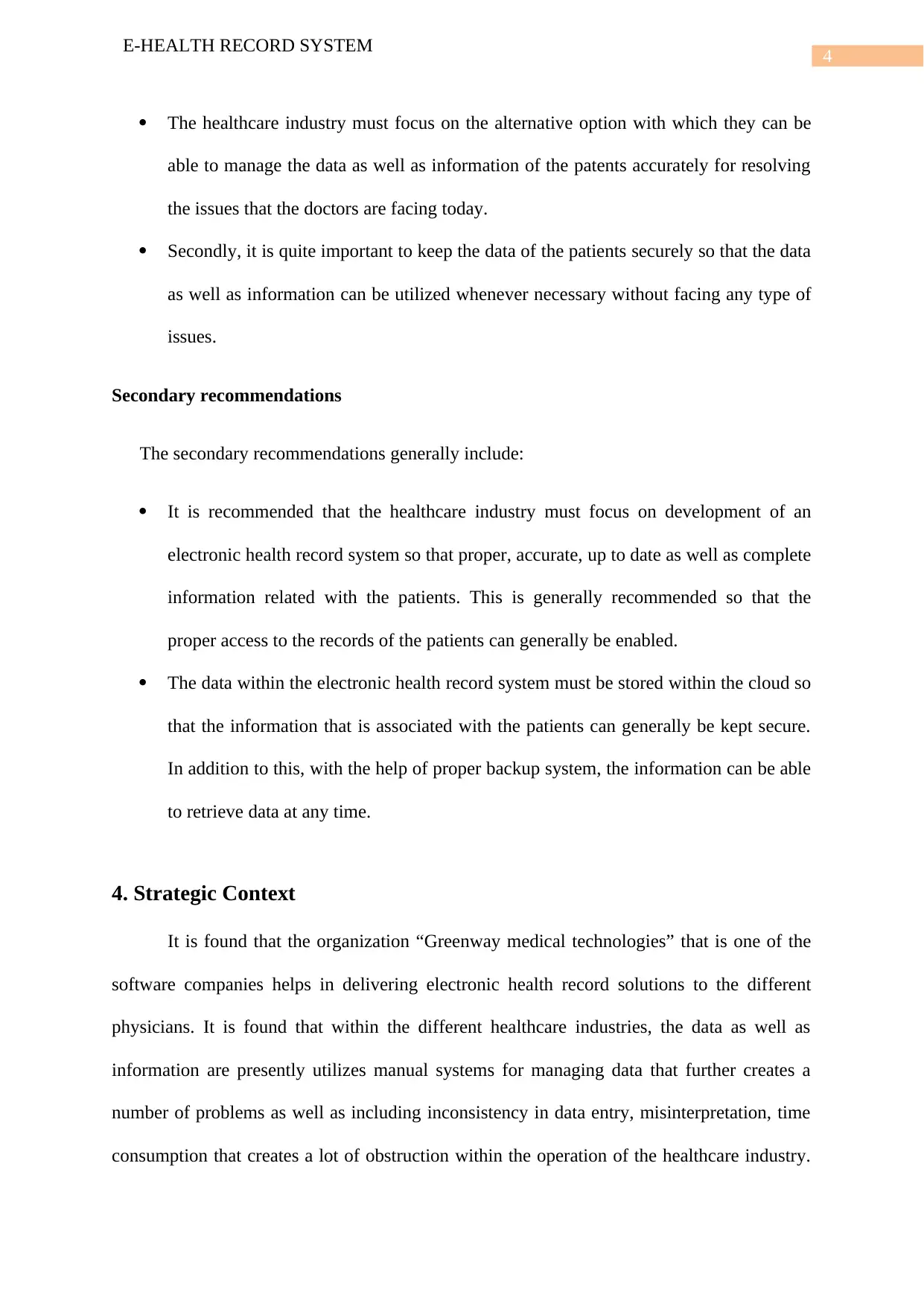
4
E-HEALTH RECORD SYSTEM
The healthcare industry must focus on the alternative option with which they can be
able to manage the data as well as information of the patents accurately for resolving
the issues that the doctors are facing today.
Secondly, it is quite important to keep the data of the patients securely so that the data
as well as information can be utilized whenever necessary without facing any type of
issues.
Secondary recommendations
The secondary recommendations generally include:
It is recommended that the healthcare industry must focus on development of an
electronic health record system so that proper, accurate, up to date as well as complete
information related with the patients. This is generally recommended so that the
proper access to the records of the patients can generally be enabled.
The data within the electronic health record system must be stored within the cloud so
that the information that is associated with the patients can generally be kept secure.
In addition to this, with the help of proper backup system, the information can be able
to retrieve data at any time.
4. Strategic Context
It is found that the organization “Greenway medical technologies” that is one of the
software companies helps in delivering electronic health record solutions to the different
physicians. It is found that within the different healthcare industries, the data as well as
information are presently utilizes manual systems for managing data that further creates a
number of problems as well as including inconsistency in data entry, misinterpretation, time
consumption that creates a lot of obstruction within the operation of the healthcare industry.
E-HEALTH RECORD SYSTEM
The healthcare industry must focus on the alternative option with which they can be
able to manage the data as well as information of the patents accurately for resolving
the issues that the doctors are facing today.
Secondly, it is quite important to keep the data of the patients securely so that the data
as well as information can be utilized whenever necessary without facing any type of
issues.
Secondary recommendations
The secondary recommendations generally include:
It is recommended that the healthcare industry must focus on development of an
electronic health record system so that proper, accurate, up to date as well as complete
information related with the patients. This is generally recommended so that the
proper access to the records of the patients can generally be enabled.
The data within the electronic health record system must be stored within the cloud so
that the information that is associated with the patients can generally be kept secure.
In addition to this, with the help of proper backup system, the information can be able
to retrieve data at any time.
4. Strategic Context
It is found that the organization “Greenway medical technologies” that is one of the
software companies helps in delivering electronic health record solutions to the different
physicians. It is found that within the different healthcare industries, the data as well as
information are presently utilizes manual systems for managing data that further creates a
number of problems as well as including inconsistency in data entry, misinterpretation, time
consumption that creates a lot of obstruction within the operation of the healthcare industry.
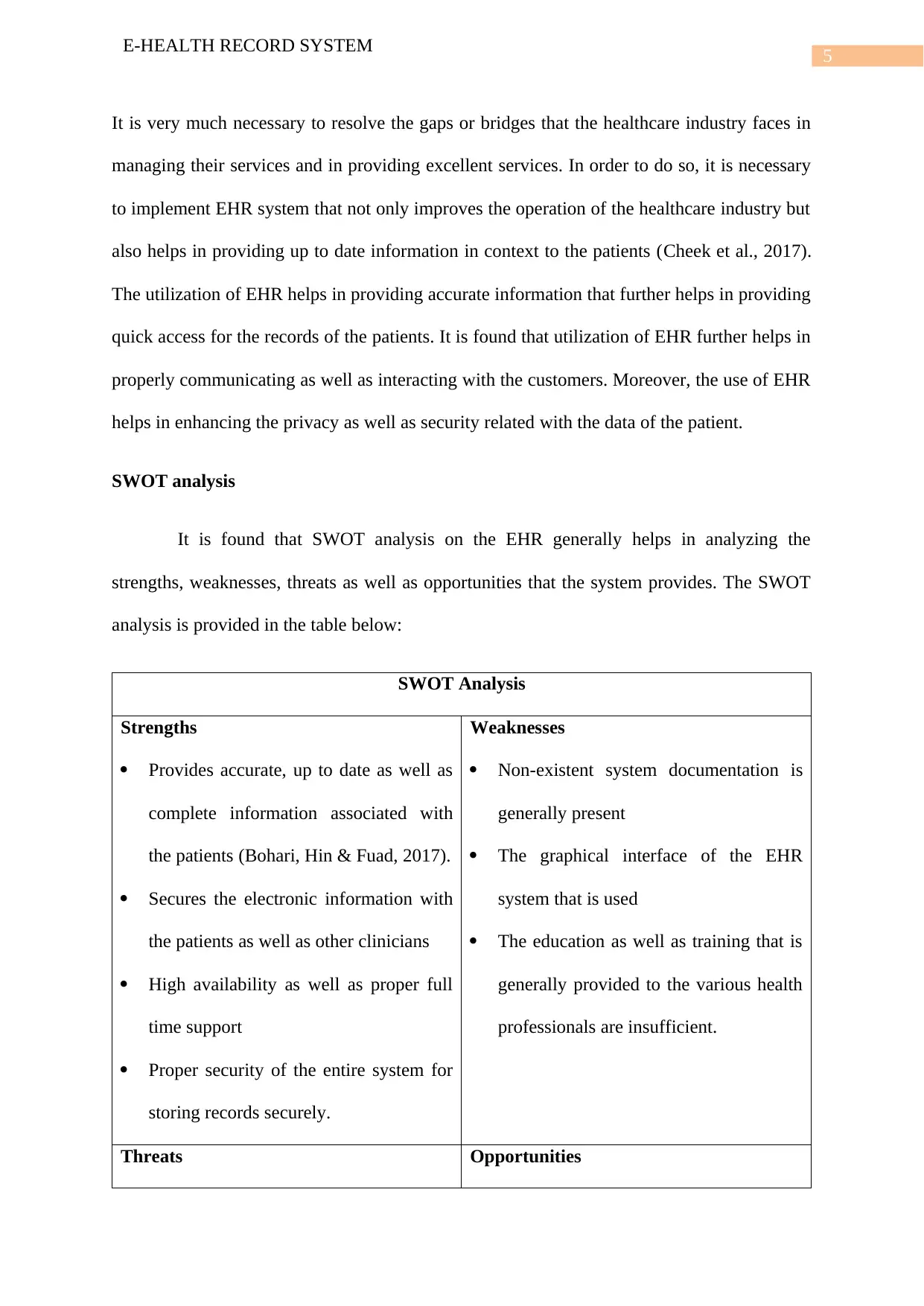
5
E-HEALTH RECORD SYSTEM
It is very much necessary to resolve the gaps or bridges that the healthcare industry faces in
managing their services and in providing excellent services. In order to do so, it is necessary
to implement EHR system that not only improves the operation of the healthcare industry but
also helps in providing up to date information in context to the patients (Cheek et al., 2017).
The utilization of EHR helps in providing accurate information that further helps in providing
quick access for the records of the patients. It is found that utilization of EHR further helps in
properly communicating as well as interacting with the customers. Moreover, the use of EHR
helps in enhancing the privacy as well as security related with the data of the patient.
SWOT analysis
It is found that SWOT analysis on the EHR generally helps in analyzing the
strengths, weaknesses, threats as well as opportunities that the system provides. The SWOT
analysis is provided in the table below:
SWOT Analysis
Strengths
Provides accurate, up to date as well as
complete information associated with
the patients (Bohari, Hin & Fuad, 2017).
Secures the electronic information with
the patients as well as other clinicians
High availability as well as proper full
time support
Proper security of the entire system for
storing records securely.
Weaknesses
Non-existent system documentation is
generally present
The graphical interface of the EHR
system that is used
The education as well as training that is
generally provided to the various health
professionals are insufficient.
Threats Opportunities
E-HEALTH RECORD SYSTEM
It is very much necessary to resolve the gaps or bridges that the healthcare industry faces in
managing their services and in providing excellent services. In order to do so, it is necessary
to implement EHR system that not only improves the operation of the healthcare industry but
also helps in providing up to date information in context to the patients (Cheek et al., 2017).
The utilization of EHR helps in providing accurate information that further helps in providing
quick access for the records of the patients. It is found that utilization of EHR further helps in
properly communicating as well as interacting with the customers. Moreover, the use of EHR
helps in enhancing the privacy as well as security related with the data of the patient.
SWOT analysis
It is found that SWOT analysis on the EHR generally helps in analyzing the
strengths, weaknesses, threats as well as opportunities that the system provides. The SWOT
analysis is provided in the table below:
SWOT Analysis
Strengths
Provides accurate, up to date as well as
complete information associated with
the patients (Bohari, Hin & Fuad, 2017).
Secures the electronic information with
the patients as well as other clinicians
High availability as well as proper full
time support
Proper security of the entire system for
storing records securely.
Weaknesses
Non-existent system documentation is
generally present
The graphical interface of the EHR
system that is used
The education as well as training that is
generally provided to the various health
professionals are insufficient.
Threats Opportunities
⊘ This is a preview!⊘
Do you want full access?
Subscribe today to unlock all pages.

Trusted by 1+ million students worldwide

6
E-HEALTH RECORD SYSTEM
The main threat is the competition as
well as market pressure
Different types of security vulnerability
including cybersecurity issues
Readiness to generally get recovered
from the disaster.
Ability of properly expanding as well as
sustaining different types of services
The main opportunity that is associated
with the electronic health record system
is that its ability of integrating with
different types of applications
Development of effective security
protocols (Bull et al., 2016).
Mission statement
The main mission statement of the organization is to provide proper facilities with the
help of EHR system so that the problems that current healthcare industries faces due to the
utilization of the manual system for managing the healthcare records. It is found that the
present system that is utilized in some of the healthcare industries creates inconsistencies in
data entry as well as creates other types of issues in managing the operations of the healthcare
organizations. Therefore, utilization of electronic health record system not only helps in
resolving issues but also helps in properly designing the application with very much high
applications including security, productivity, flexibility as well as reliability. In addition to
this, it is found that the developed healthcare system is also helpful in improving the clinical
decision support system that further assists in reducing the risks that are associated with the
provided medical facilities.
E-HEALTH RECORD SYSTEM
The main threat is the competition as
well as market pressure
Different types of security vulnerability
including cybersecurity issues
Readiness to generally get recovered
from the disaster.
Ability of properly expanding as well as
sustaining different types of services
The main opportunity that is associated
with the electronic health record system
is that its ability of integrating with
different types of applications
Development of effective security
protocols (Bull et al., 2016).
Mission statement
The main mission statement of the organization is to provide proper facilities with the
help of EHR system so that the problems that current healthcare industries faces due to the
utilization of the manual system for managing the healthcare records. It is found that the
present system that is utilized in some of the healthcare industries creates inconsistencies in
data entry as well as creates other types of issues in managing the operations of the healthcare
organizations. Therefore, utilization of electronic health record system not only helps in
resolving issues but also helps in properly designing the application with very much high
applications including security, productivity, flexibility as well as reliability. In addition to
this, it is found that the developed healthcare system is also helpful in improving the clinical
decision support system that further assists in reducing the risks that are associated with the
provided medical facilities.
Paraphrase This Document
Need a fresh take? Get an instant paraphrase of this document with our AI Paraphraser
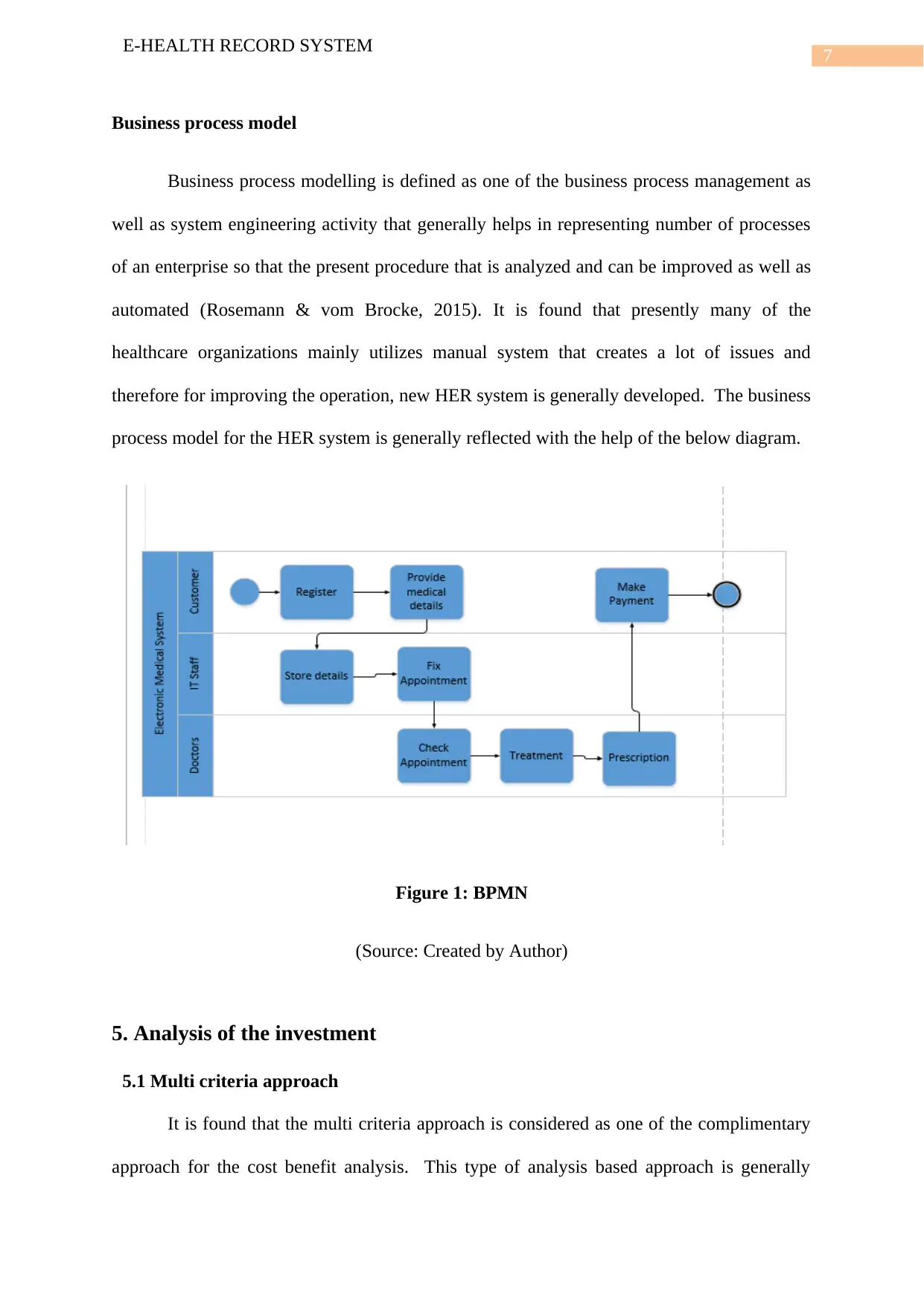
7
E-HEALTH RECORD SYSTEM
Business process model
Business process modelling is defined as one of the business process management as
well as system engineering activity that generally helps in representing number of processes
of an enterprise so that the present procedure that is analyzed and can be improved as well as
automated (Rosemann & vom Brocke, 2015). It is found that presently many of the
healthcare organizations mainly utilizes manual system that creates a lot of issues and
therefore for improving the operation, new HER system is generally developed. The business
process model for the HER system is generally reflected with the help of the below diagram.
Figure 1: BPMN
(Source: Created by Author)
5. Analysis of the investment
5.1 Multi criteria approach
It is found that the multi criteria approach is considered as one of the complimentary
approach for the cost benefit analysis. This type of analysis based approach is generally
E-HEALTH RECORD SYSTEM
Business process model
Business process modelling is defined as one of the business process management as
well as system engineering activity that generally helps in representing number of processes
of an enterprise so that the present procedure that is analyzed and can be improved as well as
automated (Rosemann & vom Brocke, 2015). It is found that presently many of the
healthcare organizations mainly utilizes manual system that creates a lot of issues and
therefore for improving the operation, new HER system is generally developed. The business
process model for the HER system is generally reflected with the help of the below diagram.
Figure 1: BPMN
(Source: Created by Author)
5. Analysis of the investment
5.1 Multi criteria approach
It is found that the multi criteria approach is considered as one of the complimentary
approach for the cost benefit analysis. This type of analysis based approach is generally

8
E-HEALTH RECORD SYSTEM
accomplished with the help of two stage analysis approach of decision making. It is found
that the first stage generally helps in the identification of different set of commercial as well
as economical goals for determining the trade-offs with other types of policies. Moreover, the
assigned policy that is mainly associated with this particular approach is helpful in
undertaking the feasibility analysis quite effectively.
5.2 Financial benefits
The figure that are provided below generally showcases the calculation for NPV, ROI,
IRR as well as breakeven point.
Year Total benefit from the Ehealth record keeping system The rate fo discount @ 7%PV profit NPV for total profit Nr profit
Initial year -$ 1 -$ -$
1st year 6,000.00$ 0.93 5,580.00$ 5,580.00$
2 nd year 8,000.00$ 0.86 6,880.00$ 12,460.00$
3rd year 10,000.00$ 0.79 7,900.00$ 20,360.00$
4th year 13,000.00$ 0.72 9,360.00$ 29,720.00$
5th year 16,000.00$ 0.65 10,400.00$ 40,120.00$ 40,120.00$
One time investment cost
Total development Cost 22,000.00$
Year Recurring Costs Discount rate @ 5% PV of Recurring Costs NPV of all Benefits total benefits
Initial year -$ 1 -$ 22,000.00$
1st year -$ 0.93 -$ 22,000.00$
2 nd year -$ 0.86 -$ 22,000.00$
3rd year -$ 0.79 -$ 22,000.00$
4th year -$ 0.72 -$ 22,000.00$
5th year -$ 0.65 -$ 22,000.00$ 22,000.00$
NPV 18,120.00$
Total ROI 0.823636364
Return on Investment and Net Present Value
Figure 2: Return on investment and net present value
(Source: Created by Author)
E-HEALTH RECORD SYSTEM
accomplished with the help of two stage analysis approach of decision making. It is found
that the first stage generally helps in the identification of different set of commercial as well
as economical goals for determining the trade-offs with other types of policies. Moreover, the
assigned policy that is mainly associated with this particular approach is helpful in
undertaking the feasibility analysis quite effectively.
5.2 Financial benefits
The figure that are provided below generally showcases the calculation for NPV, ROI,
IRR as well as breakeven point.
Year Total benefit from the Ehealth record keeping system The rate fo discount @ 7%PV profit NPV for total profit Nr profit
Initial year -$ 1 -$ -$
1st year 6,000.00$ 0.93 5,580.00$ 5,580.00$
2 nd year 8,000.00$ 0.86 6,880.00$ 12,460.00$
3rd year 10,000.00$ 0.79 7,900.00$ 20,360.00$
4th year 13,000.00$ 0.72 9,360.00$ 29,720.00$
5th year 16,000.00$ 0.65 10,400.00$ 40,120.00$ 40,120.00$
One time investment cost
Total development Cost 22,000.00$
Year Recurring Costs Discount rate @ 5% PV of Recurring Costs NPV of all Benefits total benefits
Initial year -$ 1 -$ 22,000.00$
1st year -$ 0.93 -$ 22,000.00$
2 nd year -$ 0.86 -$ 22,000.00$
3rd year -$ 0.79 -$ 22,000.00$
4th year -$ 0.72 -$ 22,000.00$
5th year -$ 0.65 -$ 22,000.00$ 22,000.00$
NPV 18,120.00$
Total ROI 0.823636364
Return on Investment and Net Present Value
Figure 2: Return on investment and net present value
(Source: Created by Author)
⊘ This is a preview!⊘
Do you want full access?
Subscribe today to unlock all pages.

Trusted by 1+ million students worldwide

9
E-HEALTH RECORD SYSTEM
Development phase Year 1 Year 2 Year 3 Year 4 Year 5 Year 6 Year 7 Year 8 Year 9 Year 10 Year 11 Year 12 Year 13 Year 14 Year 15 Year 16 Year 17 Year 18 Year 19 Year 20
Total Investment 7,00,000
Revenue 750000 825000 907500 998250 1098075 1207882.5 1328670.75 1461537.825 1607691.608 1768460.768 1945306.845 2139837.53 2353821.283 2589203.411 2848123.752 3132936.127 3446229.74 3790852.714 4169937.985 4586931.784
Cumulative cashflow -700000 50000 875000 1782500 2780750 3878825 5086707.5 6415378.25 7876916.075 9484607.683 11253068.45 13198375.3 15338212.83 17692034.11 20281237.52 23129361.27 26262297.4 29708527.14 33499379.85 37669317.84 42256249.62
Payback period 12.89951931 Years
year Total Investment Revenue Cumulative cashflow Payback period
Development phase 7,00,000.00£ 7,00,000.00-£ 12.90
Year 1 7,50,000.00£ 50,000.00£ Years
Year 2 8,25,000.00£ 8,75,000.00£
Year 3 9,07,500.00£ 17,82,500.00£
Year 4 9,98,250.00£ 27,80,750.00£
Year 5 10,98,075.00£ 38,78,825.00£
Year 6 12,07,882.50£ 50,86,707.50£
Year 7 13,28,670.75£ 64,15,378.25£
Year 8 14,61,537.83£ 78,76,916.08£
Year 9 16,07,691.61£ 94,84,607.68£
Year 10 17,68,460.77£ 1,12,53,068.45£
Year 11 19,45,306.85£ 1,31,98,375.30£
Year 12 21,39,837.53£ 1,53,38,212.83£
Year 13 23,53,821.28£ 1,76,92,034.11£
Year 14 25,89,203.41£ 2,02,81,237.52£
Year 15 28,48,123.75£ 2,31,29,361.27£
Year 16 31,32,936.13£ 2,62,62,297.40£
Year 17 34,46,229.74£ 2,97,08,527.14£
Year 18 37,90,852.71£ 3,34,99,379.85£
Year 19 41,69,937.99£ 3,76,69,317.84£
Year 20 45,86,931.78£ 4,22,56,249.62£
-£50,00,000.00
£-
£50,00,000.00
£1,00,00,000.00
£1,50,00,000.00
£2,00,00,000.00
£2,50,00,000.00
£3,00,00,000.00
£3,50,00,000.00
£4,00,00,000.00
Payback Period
Revenue Cumulative cashflow
Figure 3: Payback period
(Source: Created by Author)
Year
One time
investment
cost (E-health
record
system)
Rec
urri
ng
cost
Tota
l
inve
stme
nt Return
The rate
of
Cumulati
ve cash
flow
The
total
cash
flow
The
discou
nted
Cash
Flow
Net
Discou
nted
Cash
Flow
Pay
bac
k
pha
se
At
the
Initiat
io
phase $1,500
$
26,0
00.0
0
$
(26,000.0
0)
$
(26,0
00.0
0)
$
(26,00
0.00)
$
(26,000
.00)
12.
708
141
32
Year
1
$
-
$
5,000.
00
$
(21,000.0
0)
$
(47,0
00.0
0)
$
(19,53
0.00)
$
(45,530
.00)
year
2
$
-
$
7,000.
00
$
(14,000.0
0)
$
(61,0
00.0
0)
$
(13,02
0.00)
$
(58,550
.00)
Year
3
$
-
$
9,000.
00
$
(5,000.00
)
$
(66,0
00.0
0)
$
(4,650.
00)
$
(63,200
.00)
Year $ $ $ $ $ $
E-HEALTH RECORD SYSTEM
Development phase Year 1 Year 2 Year 3 Year 4 Year 5 Year 6 Year 7 Year 8 Year 9 Year 10 Year 11 Year 12 Year 13 Year 14 Year 15 Year 16 Year 17 Year 18 Year 19 Year 20
Total Investment 7,00,000
Revenue 750000 825000 907500 998250 1098075 1207882.5 1328670.75 1461537.825 1607691.608 1768460.768 1945306.845 2139837.53 2353821.283 2589203.411 2848123.752 3132936.127 3446229.74 3790852.714 4169937.985 4586931.784
Cumulative cashflow -700000 50000 875000 1782500 2780750 3878825 5086707.5 6415378.25 7876916.075 9484607.683 11253068.45 13198375.3 15338212.83 17692034.11 20281237.52 23129361.27 26262297.4 29708527.14 33499379.85 37669317.84 42256249.62
Payback period 12.89951931 Years
year Total Investment Revenue Cumulative cashflow Payback period
Development phase 7,00,000.00£ 7,00,000.00-£ 12.90
Year 1 7,50,000.00£ 50,000.00£ Years
Year 2 8,25,000.00£ 8,75,000.00£
Year 3 9,07,500.00£ 17,82,500.00£
Year 4 9,98,250.00£ 27,80,750.00£
Year 5 10,98,075.00£ 38,78,825.00£
Year 6 12,07,882.50£ 50,86,707.50£
Year 7 13,28,670.75£ 64,15,378.25£
Year 8 14,61,537.83£ 78,76,916.08£
Year 9 16,07,691.61£ 94,84,607.68£
Year 10 17,68,460.77£ 1,12,53,068.45£
Year 11 19,45,306.85£ 1,31,98,375.30£
Year 12 21,39,837.53£ 1,53,38,212.83£
Year 13 23,53,821.28£ 1,76,92,034.11£
Year 14 25,89,203.41£ 2,02,81,237.52£
Year 15 28,48,123.75£ 2,31,29,361.27£
Year 16 31,32,936.13£ 2,62,62,297.40£
Year 17 34,46,229.74£ 2,97,08,527.14£
Year 18 37,90,852.71£ 3,34,99,379.85£
Year 19 41,69,937.99£ 3,76,69,317.84£
Year 20 45,86,931.78£ 4,22,56,249.62£
-£50,00,000.00
£-
£50,00,000.00
£1,00,00,000.00
£1,50,00,000.00
£2,00,00,000.00
£2,50,00,000.00
£3,00,00,000.00
£3,50,00,000.00
£4,00,00,000.00
Payback Period
Revenue Cumulative cashflow
Figure 3: Payback period
(Source: Created by Author)
Year
One time
investment
cost (E-health
record
system)
Rec
urri
ng
cost
Tota
l
inve
stme
nt Return
The rate
of
Cumulati
ve cash
flow
The
total
cash
flow
The
discou
nted
Cash
Flow
Net
Discou
nted
Cash
Flow
Pay
bac
k
pha
se
At
the
Initiat
io
phase $1,500
$
26,0
00.0
0
$
(26,000.0
0)
$
(26,0
00.0
0)
$
(26,00
0.00)
$
(26,000
.00)
12.
708
141
32
Year
1
$
-
$
5,000.
00
$
(21,000.0
0)
$
(47,0
00.0
0)
$
(19,53
0.00)
$
(45,530
.00)
year
2
$
-
$
7,000.
00
$
(14,000.0
0)
$
(61,0
00.0
0)
$
(13,02
0.00)
$
(58,550
.00)
Year
3
$
-
$
9,000.
00
$
(5,000.00
)
$
(66,0
00.0
0)
$
(4,650.
00)
$
(63,200
.00)
Year $ $ $ $ $ $
Paraphrase This Document
Need a fresh take? Get an instant paraphrase of this document with our AI Paraphraser

10
E-HEALTH RECORD SYSTEM
4 -
12,000
.00 7,000.00
(59,0
00.0
0)
6,510.0
0
(56,690
.00)
Year
5
$
-
$
15,000
.00
$
22,000.0
0
$
(37,0
00.0
0)
$
20,460.
00
$
(36,230
.00)
At the
Initiatio
phase
Year 1 year 2 Year 3 Year 4 Year 5
$(30,000.00)
$(20,000.00)
$(10,000.00)
$-
$10,000.00
$20,000.00
$30,000.00
Period for Breakeven
Figure 4: Payback period
(Source: Created by Author)
5.3 Non financial benefits
Use of key performance indicators
The key performance indicators are generally defined as one of the procedure that is
generally utilized in order to obtain proper measurable results that further helps the owners of
the business in improving the sales, customer satisfaction as well as return on investment
(Akkermans & Van Oorschot, 2018). The benefits which are generally achieved due to the
utilization of the key performance indicators within the business operations are generally
listed below:
E-HEALTH RECORD SYSTEM
4 -
12,000
.00 7,000.00
(59,0
00.0
0)
6,510.0
0
(56,690
.00)
Year
5
$
-
$
15,000
.00
$
22,000.0
0
$
(37,0
00.0
0)
$
20,460.
00
$
(36,230
.00)
At the
Initiatio
phase
Year 1 year 2 Year 3 Year 4 Year 5
$(30,000.00)
$(20,000.00)
$(10,000.00)
$-
$10,000.00
$20,000.00
$30,000.00
Period for Breakeven
Figure 4: Payback period
(Source: Created by Author)
5.3 Non financial benefits
Use of key performance indicators
The key performance indicators are generally defined as one of the procedure that is
generally utilized in order to obtain proper measurable results that further helps the owners of
the business in improving the sales, customer satisfaction as well as return on investment
(Akkermans & Van Oorschot, 2018). The benefits which are generally achieved due to the
utilization of the key performance indicators within the business operations are generally
listed below:

11
E-HEALTH RECORD SYSTEM
The key performance indicators mainly help in tracking as well as monitoring the
approaches
It is found that the problem can be identified in its initial stage with the help of this
particular approach
The utilization of key performance indicators also helps in improving the marketing
flexibilities
Balanced scorecard
Balanced scorecard is defined as one of the strategic procedure that is generally
utilized as one of the important managerial tool in order to aligning the activities of the
business with the mission, vision as well as with the strategic operations of the organization.
It vis found that for improving both the external as well as internal communication, this tool
is considered to be quite beneficial (Keyes, 2016). The balanced scorecard is utilized within
the healthcare record system that is generally reflected in the table below:
Aim Strategic
imperatives
Performance
measured
Initiatives
Survey of internal
procedure
Proper analysis of
various types of
deployment related
requirements
Proper tracking as
well as management
Undertaking survey
Readiness of the
medical records
Individual readiness The usage of the
electronic health
record system
Proper
implementation of th
doctor medical home
implementation
Tracking as well as
E-HEALTH RECORD SYSTEM
The key performance indicators mainly help in tracking as well as monitoring the
approaches
It is found that the problem can be identified in its initial stage with the help of this
particular approach
The utilization of key performance indicators also helps in improving the marketing
flexibilities
Balanced scorecard
Balanced scorecard is defined as one of the strategic procedure that is generally
utilized as one of the important managerial tool in order to aligning the activities of the
business with the mission, vision as well as with the strategic operations of the organization.
It vis found that for improving both the external as well as internal communication, this tool
is considered to be quite beneficial (Keyes, 2016). The balanced scorecard is utilized within
the healthcare record system that is generally reflected in the table below:
Aim Strategic
imperatives
Performance
measured
Initiatives
Survey of internal
procedure
Proper analysis of
various types of
deployment related
requirements
Proper tracking as
well as management
Undertaking survey
Readiness of the
medical records
Individual readiness The usage of the
electronic health
record system
Proper
implementation of th
doctor medical home
implementation
Tracking as well as
⊘ This is a preview!⊘
Do you want full access?
Subscribe today to unlock all pages.

Trusted by 1+ million students worldwide
1 out of 28
Related Documents
Your All-in-One AI-Powered Toolkit for Academic Success.
+13062052269
info@desklib.com
Available 24*7 on WhatsApp / Email
![[object Object]](/_next/static/media/star-bottom.7253800d.svg)
Unlock your academic potential
Copyright © 2020–2025 A2Z Services. All Rights Reserved. Developed and managed by ZUCOL.





